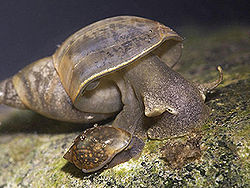| Hygrophila | |
|---|---|
 | |
| The larger of the two snails is Lymnaea stagnalis , family Lymnaeidae; the smaller one is Physella acuta , family Physidae | |
| Scientific classification | |
| Domain: | Eukaryota |
| Kingdom: | Animalia |
| Phylum: | Mollusca |
| Class: | Gastropoda |
| Infraclass: | Euthyneura |
| Subterclass: | Tectipleura |
| Subcohort: | Panpulmonata |
| Superorder: | Hygrophila Férussac, 1822 |
| Superfamilies | |
See text | |
| Synonyms [1] | |
Basommatophora | |
Hygrophila is a taxonomic superorder of air-breathing freshwater snails, aquatic pulmonate gastropod mollusks within the clade Panpulmonata. [2] [1]
Contents
The families in this clade are basically air-breathing freshwater snails including freshwater limpets. The three families with the greatest number of species are the Lymnaeidae (pond snails), the Planorbidae (ramshorn snails) and the Physidae (pouch or bubble snails). These are found in ponds, creeks, ditches, and shallow lakes nearly worldwide.
The snails in this clade have their eyes located at the base of their tentacles, rather than at the tips, as in the true land snails Stylommatophora. They have shells that are thin, translucent, and relatively colorless, and they lack an operculum.